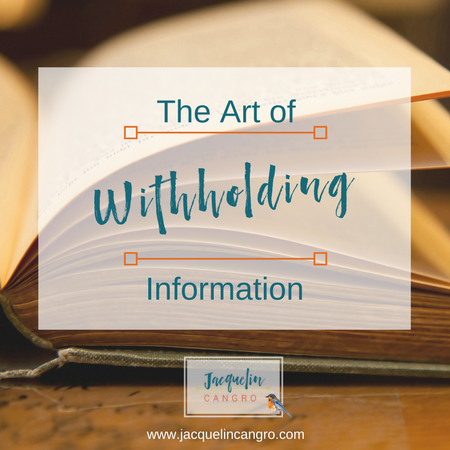I was at a writing group recently when a fellow writer felt a few scenes in her novel were dragging. She was concerned readers would be bored. (The death knell for a novel!) The solution, she decided, was to create a bit of intrigue and drama. To do that, she is planning to rewrite the scenes to conceal pertinent details, thereby ramping up the suspense. The narrator (3rd person) will not call out the main character’s decisions to act. Why does the character take a rush flight to Paris? Who does the character text as she is boarding the flight? Who will be waiting for her in the airport? The reader, no longer bored, will frantically turn the pages to get the answers. I have to admit, I am a bit leery of this plan. Withholding critical information that purposely misleads the reader can be tricky at best and erodes trust at worst.
There are no hard and fast rules, of course. Red herrings abound in fiction, especially thrillers or mysteries, and unreliable narrators are the mainstay of stories from The Catcher in the Rye to Catch-22. Withholding information isn’t necessarily a bad thing, if done judiciously, but I worry that trying to lure the reader with vague tidbits will lead to frustration.

For example, let’s say that every time the main character passes the local Taco Bell, he shudders and remembers the bad thing that happened there, but he can’t talk about it. The writer may think she is hooking the reader by having the character muse about the bad thing but not reveal exactly what it is. If this taunt (and that’s kind of what it feels like to the reader) is tossed about too many times, the reader may become annoyed. Whatever took place at the Taco Bell will need to be a humdinger.
The way in which information is kept from the reader is key. Let’s look at ways plot events can be communicated from narrator to reader.
- The reader knows what the character knows. Remember the television series Lost? There were strange occurrences that left the audience baffled for many episodes. Viewers accepted being in the dark because the characters were in the dark, too. We were all in it together.
- The reader knows more than the character knows. This option can be very suspenseful. Think about the film Psycho. We know Norman Bates is approaching the shower, but Marion Crane doesn’t.
- The character knows more than the reader knows. This is when the danger of frustration and confusion arises from dangling that carrot in front of the reader.
If I sense the writer is misusing suspense, the story begins to take on a Wizard of Oz quality where I can see man behind the curtain. The magic of the story evaporates and I often stop reading. Building suspense that feels, well, suspenseful, lies in posing the right question.
The what questions, as in What did the character do next, are less intriguing. We are really more drawn in by the why and how questions, as in Why did that happen and How did it happen.
The suspense is in the why and how more than the what. The what is strictly plot points. (This happens, then this happens, then this happens…) The why and the how are character driven. The answers to those questions are borne from this specific character’s personality, her hopes, her flaws, her dreams, her consequences.
What do you think? Do you feel deceived if an author tries to create suspense by withholding information? I’d love to hear in the comments.



Hi Jackie,
This is a great post. B. A. Paris’ thrillers are so psychologically suspenseful you can’t put them down, marveling at how she weaves such a tight web of deceit developing her psychopathic character. The reader sees the deceit so doesn’t feel personally deceived. Instead, awed by how deceived everyone else is. Her newest, BRING ME BACK, due out soon, I can’t wait to read it, and it’s not a genre I often turn to. BREAKDOWN was her debut, followed by BEHIND CLOSED DOORS. Lorraine
It sounds like the author has managed to create a layered character who is deceitful yet so compelling the reader is rooting for her anyway. Letting the reader “behind the curtain” to see the character’s true colors creates more suspense by witnessing the impact on the other characters. Thank you for sharing this insightful example, Lorraine!
I never thought about this before, but am seeing it in more and more novels. You’re right that it has to be a humdinger and overuse is really annoying. I don’t mind having info withheld if it’s done right, as in Eleanor Oliphant is Completely Fine. I knew I’d find out what happened to her eventually and it made me read faster.
If this device is used and the surprise is a dud, I do feel cheated. All that for nothing?
I think the best use of suspense in a movie is Rear Window. No matter how many times I’ve watched it, I’m still on the edge of my seat. And I’m barely refraining from yelling at Grace Kelly to look out. 🙂